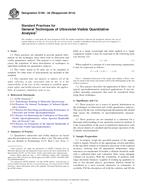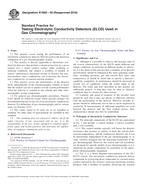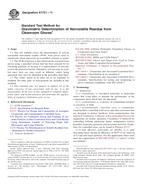Potřebujeme váš souhlas k využití jednotlivých dat, aby se vám mimo jiné mohly ukazovat informace týkající se vašich zájmů. Souhlas udělíte kliknutím na tlačítko „OK“.
ASTM D6591-11
Standard Test Method for Determination of Aromatic Hydrocarbon Types in Middle Distillates—High Performance Liquid Chromatography Method with Refractive Index Detection
Automaticky přeložený název:
Standardní zkušební metoda pro stanovení druhů aromatického uhlovodíku ve středních destilátů & ndash; High Performance kapalinové chromatografie s indexem lomu detekce
NORMA vydána dne 1.12.2011
Informace o normě:
Označení normy: ASTM D6591-11
Poznámka: NEPLATNÁ
Datum vydání normy: 1.12.2011
Kód zboží: NS-35764
Počet stran: 9
Přibližná hmotnost: 27 g (0.06 liber)
Země: Americká technická norma
Kategorie: Technické normy ASTM
Kategorie - podobné normy:
Anotace textu normy ASTM D6591-11 :
Keywords:
aromatic hydrocarbons, aromatics, diesel fuel, high performance liquid chromatography, hydrocarbon types, petroleum distillates, refractive index detection, total aromatics in fuel, Total aromatics in fuel, Aromatic hydrocarbons (AHs), Diesel engine fuel oils, HPLC (high performance liquid chromatography), Hydrocarbons, Petroleum distillates, Refractive index, ICS Number Code 71.040.50 (Physicochemical methods of analysis)
Doplňující informace
| Significance and Use | ||||||||||||||
|
The aromatic hydrocarbon content of motor diesel fuel is a factor that can affect exhaust emissions and fuel combustion characteristics, as measured by cetane number. The United States Environmental Protection Agency (US EPA) regulates the aromatic content of diesel fuels. California Air Resources Board (CARB) regulations place limits on the total aromatics content and polynuclear aromatic hydrocarbon content of motor diesel fuel, thus requiring an appropriate analytical determination to ensure compliance with the regulations. This test method is applicable to materials in the same boiling range as motor diesel fuels and is unaffected by fuel coloration. Test Method D1319, which has been mandated by the US EPA for the determination of aromatics in motor diesel fuel, excludes materials with final boiling points greater than 315°C (600°F) from its scope. Test Method D2425 is applicable to the determination of both total aromatics and polynuclear aromatic hydrocarbons in diesel fuel, but is much more costly and time-consuming to perform. Test Method D5186, currently specified by CARB, is also applicable to the determination of both total aromatics and polynuclear aromatic hydrocarbons in diesel fuel. Test Method D5186, however, specifies the use of supercritical fluid chromatography equipment that may not be readily available. Note 2—Test Method D5186 was previously specified by CARB as an alternative to Test Method D1319. |
||||||||||||||
| 1. Scope | ||||||||||||||
|
1.1 This test method covers a high performance liquid chromatographic test method for the determination of mono-aromatic, di-aromatic, tri+-aromatic, and polycyclic aromatic hydrocarbon contents in diesel fuels and petroleum distillates boiling in the range from 150 to 400°C. The total aromatic content in % m/m is calculated from the sum of the corresponding individual aromatic hydrocarbon types. Note 1—Aviation fuels and petroleum distillates with a boiling point range from 50 to 300°C are not determined by this test method and should be analyzed by Test Method, D6379 or other suitable equivalent test methods. 1.2 The precision of this test method has been established for diesel fuels and their blending components, containing from 4 to 40 % (m/m) mono-aromatic hydrocarbons, 0 to 20 % (m/m) di-aromatic hydrocarbons, 0 to 6 % (m/m) tri+-aromatic hydrocarbons, 0 to 26 % (m/m) polycyclic aromatic hydrocarbons, and 4 to 65 % (m/m) total aromatic hydrocarbons. 1.3 Compounds containing sulfur, nitrogen, and oxygen are possible interferents. Mono-alkenes do not interfere, but conjugated di- and poly-alkenes, if present, are possible interferents. 1.4 By convention, this standard defines the aromatic hydrocarbon types on the basis of their elution characteristics from the specified liquid chromatography column relative to model aromatic compounds. Quantification is by external calibration using a single aromatic compound, which may or may not be representative of the aromatics in the sample, for each aromatic hydrocarbon type. Alternative techniques and methods may classify and quantify individual aromatic hydrocarbon types differently. 1.5 Fatty Acid Methyl Esters (FAME), if present, interfere with tri+-aromatic hydrocarbons. If this method is used for diesel containing FAME, the amount of tri+-aromatics will be over estimated. 1.6 This standard does not purport to address all of the safety concerns, if any, associated with its use. It is the responsibility of the user of this standard to establish appropriate safety and health practices and determine the applicability of regulatory limitations prior to use. |
||||||||||||||
| 2. Referenced Documents | ||||||||||||||
|
Podobné normy:
Historická
1.8.2014
Historická
1.11.2010
Historická
1.11.2009
Historická
1.5.2011
Historická
1.4.2008
Historická
1.6.2006
Doporučujeme:
Aktualizace zákonů
Chcete mít jistotu o platnosti užívaných předpisů?
Nabízíme Vám řešení, abyste mohli používat stále platné (aktuální) legislativní předpisy.
Chcete vědět více informací? Podívejte se na tuto stránku.



 ASTM E169-04(2014)..
ASTM E169-04(2014).. ASTM E1698-95(2010)..
ASTM E1698-95(2010).. ASTM E1726-01(2009)..
ASTM E1726-01(2009).. ASTM E1731-11
ASTM E1731-11 ASTM E1754-08
ASTM E1754-08 ASTM E1770-95(2006)..
ASTM E1770-95(2006)..
 Cookies
Cookies
